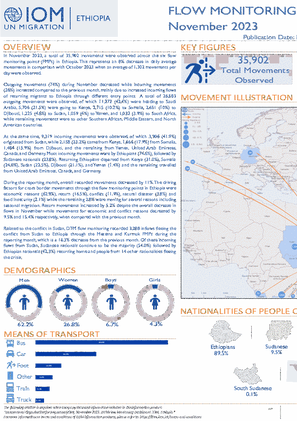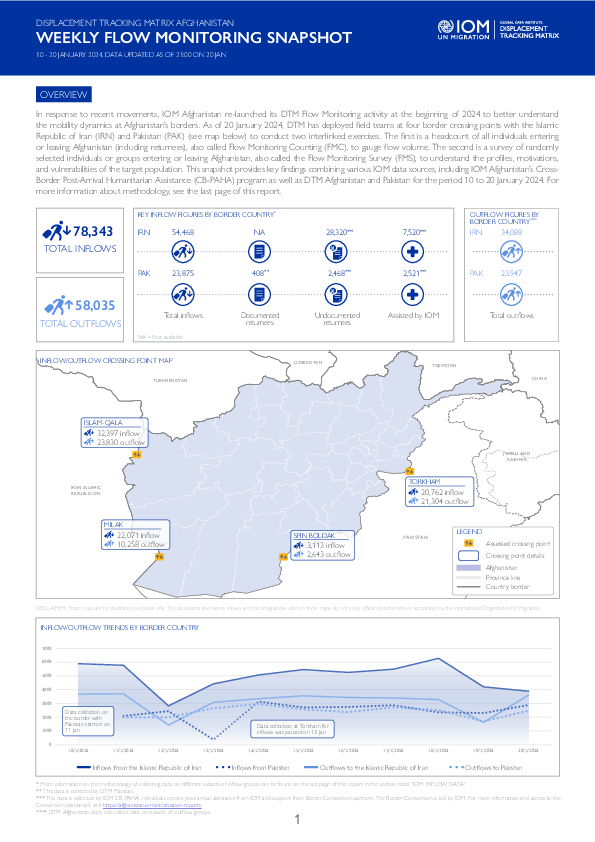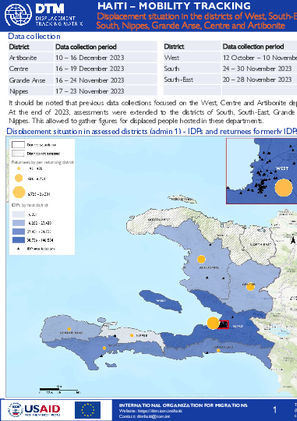-
Countries
-
Data and Analysis
-
Special Focus
-
Crisis Responses
Compilation/Overview
Color
white

Contact
Angélica Madrigal amadrigal@iom.int
Language
English
Location
Costa Rica
Period Covered
Jan 01 2024
Jan 30 2024
Activity
- Survey
- Registration
- Flow Monitoring
Cantones: Alajuela, Cartago, Corredores, Desamparados, Heredia, Liberia, Los Chiles, San Carlos, San José, Santa Ana y Tibás
Costa Rica, al igual que los demás países de la región centroamericana, se ha caracterizado por ser un corredor migratorio para personas que transitan de manera terrestre desde el sur hasta el norte de América y que tienen como destino los países del norte del continente. Este flujo en situación de movilidad por las Américas se encuentra compuesto principalmente por personas de la República Bolivariana de Venezuela, Cuba, Haití, Ecuador, así como personas provenientes de otros países de Suramérica, África y Asia.
Según estimaciones de la OIM Costa Rica, durante enero ingresaron al país 37.436 personas, un promedio aproximado de 1.208 personas por día y estimando un aumento de un 30% con respecto a diciembre de 2023. Además, se identificaron 1.407 personas varadas en los albergues monitoreados y 732 personas varadas en los sitios públicos visitados.

Contact
DTMAfghanistan@iom.int
Language
English
Location
Afghanistan
Period Covered
Feb 04 2024
Feb 10 2024
Activity
- Survey
- Flow Monitoring Survey
- Flow Monitoring
In response to recent movements, IOM Afghanistan re-launched its DTM Flow Monitoring activity at the beginning of 2024 to better understand the mobility dynamics at Afghanistan’s borders. Since 10 January 2024, DTM has deployed field teams at four border crossing points with the Islamic Republic of Iran (IRN) and Pakistan (PAK) (see map below) to conduct two interlinked exercises. The first is a headcount of all individuals entering or leaving Afghanistan (including returnees), also called Flow Monitoring Counting (FMC), to gauge flow volume. The second is a survey of randomly selected Afghan national individuals or groups entering or leaving Afghanistan, also called the Flow Monitoring Survey (FMS), to understand the profiles, motivations, and vulnerabilities of the target population. This snapshot provides key findings combining various IOM data sources, including DTM Afghanistan’s FMC and FMS activities, DTM Pakistan’s Flow Monitoring of Afghan returnees, and IOM Afghanistan’s Cross-Border Post-Arrival Humanitarian Assistance (CB-PAHA) program, for the period 4 to 10 February 2024. For more information about methodology, see the the section in the last page of this report titled “IOM INFLOWS.”

Contact
DTMAfghanistan@iom.int
Language
English
Location
Afghanistan
Period Covered
Jan 28 2024
Mar 03 2024
Activity
- Survey
- Flow Monitoring Survey
- Flow Monitoring
In response to recent movements, IOM Afghanistan re-launched its DTM Flow Monitoring activity at the beginning of 2024 to better understand the mobility dynamics at Afghanistan’s borders. Since 10 January 2024, DTM has deployed field teams at four border crossing points with the Islamic Republic of Iran (IRN) and Pakistan (PAK) (see map below) to conduct two interlinked exercises. The first is a headcount of all individuals entering or leaving Afghanistan (including returnees), also called Flow Monitoring Counting (FMC), to gauge flow volume. The second is a survey of randomly selected Afghan national individuals or groups entering or leaving Afghanistan, also called the Flow Monitoring Survey (FMS), to understand the profiles, motivations, and vulnerabilities of the target population. This snapshot provides key findings combining various IOM data sources, including DTM Afghanistan’s FMC and FMS activities, DTM Pakistan’s Flow Monitoring of Afghan returnees, and IOM Afghanistan’s Cross-Border Post-Arrival Humanitarian Assistance (CB-PAHA) program, for the period 28 January to 3 February 2024. For more information about methodology, see the the section in the last page of this report titled “IOM INFLOWS.”

Contact
DTM Ethiopia, DTMEthiopia@iom.int
Language
English
Location
Ethiopia
Period Covered
Nov 01 2023
Nov 30 2023
Activity
- Flow Monitoring
In November 2023, a total of 35,902 movements were observed across the six flow monitoring points (FMPs) in Ethiopia. This represents an 8% decrease in daily average movements in comparison with October 2023 when an average of 1,302 movements per day were observed.
Outgoing movements (74%) during November decreased while incoming movements (26%) increased compared to the previous month, mainly due to increased incoming flows of returning migrants to Ethiopia through different entry points. A total of 26,583 outgoing movements were observed, of which 11,272 (42.4%) were heading to Saudi Arabia, 5,706 (21.5%) were going to Kenya, 2,715 (10.2%) to Somalia, 2,651 (10%) to Djibouti, 1,225 (4.6%) to Sudan, 1,059 (4%) to Yemen, and 1,032 (3.9%) to South Africa, while remaining movements were to other Southern African, Middle Eastern, and North American countries.
At the same time, 9,319 incoming movements were observed, of which 3,906 (41.9%) originated from Sudan, while 2,158 (23.2%) came from Kenya, 1,666 (17.9%) from Somalia, 1,484 (15.9%) from Djibouti, and the remaining from Yemen, United Arab Emirates, Canada, and Germany. Most incoming movements were by Ethiopians (74.6%), followed by Sudanese nationals (23.8%). Returning Ethiopians departed from Kenya (31.0%), Somalia (24.0%), Sudan (22.5%), Djibouti (21.1%), and Yemen (1.4%) and the remaining travelled from United Arab Emirates, Canada, and Germany.

Contact
DTMAfghanistan@iom.int
Language
English
Location
Afghanistan
Period Covered
Feb 21 2024
Feb 27 2024
Activity
- Survey
- Flow Monitoring Survey
- Flow Monitoring
In response to recent movements, IOM Afghanistan re-launched its DTM Flow Monitoring activity at the beginning of 2024 to better understand the mobility dynamics at Afghanistan’s borders. Since 10 January, DTM has deployed field teams at four border crossing points with the Islamic Republic of Iran (IRN) and Pakistan (PAK) (see map below) to conduct two interlinked exercises. The first is a headcount of all individuals entering or leaving Afghanistan (including returnees), also called Flow Monitoring Counting (FMC), to gauge flow volume. The second is a survey of randomly selected individuals or groups entering or leaving Afghanistan, also called the Flow Monitoring Survey (FMS), to understand the profiles, motivations, and vulnerabilities of the target population. This snapshot provides key findings combining various IOM data sources, including IOM Afghanistan’s Cross-Border Post-Arrival Humanitarian Assistance (CB-PAHA) program as well as DTM Afghanistan and Pakistan for the period 21 to 27 January 2024. For more information about methodology, see the last page of this report.

Contact
DTMAfghanistan@iom.int
Language
English
Location
Afghanistan
Period Covered
Jan 10 2024
Jan 20 2024
Activity
- Survey
- Flow Monitoring Survey
- Flow Monitoring
In response to recent movements, IOM Afghanistan re-launched its DTM Flow Monitoring activity at the beginning of 2024 to better understand the mobility dynamics at Afghanistan’s borders. Since 10 January, DTM has deployed field teams at four border crossing points with the Islamic Republic of Iran (IRN) and Pakistan (PAK) (see map below) to conduct two interlinked exercises. The first is a headcount of all individuals entering or leaving Afghanistan (including returnees), also called Flow Monitoring Counting (FMC), to gauge flow volume. The second is a survey of randomly selected individuals or groups entering or leaving Afghanistan, also called the Flow Monitoring Survey (FMS), to understand the profiles, motivations, and vulnerabilities of the target population. This snapshot provides key findings combining various IOM data sources, including IOM Afghanistan’s Cross-Border Post-Arrival Humanitarian Assistance (CB-PAHA) program as well as DTM Afghanistan and Pakistan for the period 10 to 20 January 2024. An interactive dashboard on all data collected since the inception of the Flow Monitoring activity on 10 January can be found HERE.

Contact
mtmuzbekistan@iom.int
Language
English
Location
Uzbekistan
Period Covered
Apr 01 2024
Sep 30 2024
Activity
- Flow Monitoring Survey
- Migrants presence
- Mobility Tracking
Mazkur hisobot 2023-yilning aprel-sentabr oylari uchun ichki va tashqi ko‘chishlar hamda migrantlar guruhlari bo‘yicha milliy va xalqaro maʼlumotlar to‘plamlaridan olingan ochiq maʼlumotlarga asoslanib, O‘zbekistondagi migratsiyaga oid so‘nggi maʼlumotlar va jarayonlarni qamrab oladi. Hisobot mamlakatdagi ichki va xalqaro migratsiyaga ta’sir ko‘rsatuvchi so‘nggi yirik global va mintaqaviy voqealarni, xususan, Rossiyaning Ukrainaga bosqini davom etishi hamda buning natijasida mintaqadagi an’anaviy insonlar mobillligi shakllarining o‘zgarishi, shuningdek, urbanizatsiya jarayoni, iqlim o‘zgarishi va o‘sib borayotgan suv tanqisligi kabi masalalar insonlar mobilligini ta’minlovchi omillar sifatida aks ettiradi.
The early warning and monitoring tool on the situation in the Gulf of Guinea coastal countries (Ghana, Benin, Togo and Côte d'Ivoire), as of 31 July 2022, developed by the GRANIT under the direction of OCHA, IOM and REACH, monitors, based on data and analysis provided by humanitarian and development partners, trends relative to key indicators relating to the situation in the four coastal countries, as of 30 November 2023.
This report examines the evolution of the situation in Ghana, Togo, Benin and Côte d'Ivoire in terms of :
- Security incidents
- Types and frequency of violence
- Forced displacement of IDPs and Refugees
- Operational status of international borders
- Food security
- Community dynamics
- Human rights

Contact
iomtashkent@iom.int
Language
English
Location
Uzbekistan
Period Covered
Jan 01 2023
Sep 30 2023
Activity
- Flow Monitoring Survey
- Mobility Tracking
This report demonstrates the latest data and trends concerning migration in Uzbekistan,drawing upon data available for April-September 2023 from national and international datasets on internal and external movements and migrant population groups. It encompasses recent major global and regional events that have influenced internal and international migration in the country, such as the continuance of the Russian invasion of Ukraine and the resulting in changes to habitual mobility patterns in the region; the urbanization process; climate change and the growing water deficit as contributing factors of the human mobility

Contact
DTM Haiti, dtmhaiti@iom.int
Language
English
Location
Haiti
Period Covered
Oct 12 2023
Dec 19 2023
Activity
- Mobility Tracking
- Site Assessment
- Baseline Assessment
- Village Assessment
In recent years, widespread insecurity in Haiti has caused thousands of people to flee their areas of residence. Although the violence most often occurs in the Port-au-Prince Metropolitan Area (PAPMA) located in the West district, other departments are also affected as more and more people leave the PAPMA to take refuge in provincial districts.
This report presents key results of DTM assessments conducted end of 2023 in the districts of West, South, South-East, Artibonite, Grande Anse, Centre and Nippes on the displacement situation in the country. In total, 313,901 persons are internally displaced in the country, the majority of them being children (55%). Results indicate that 147,000 persons have fled the PAPMA to take refuge in provincial districts.
Pagination
- Previous page
- Page 13
- Next page
